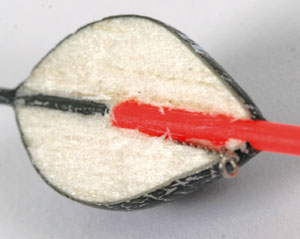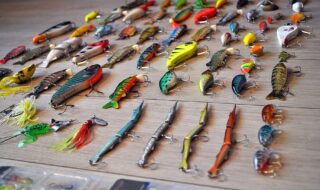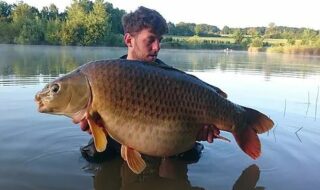The tcf team looks at bristles, eyes, stems and bodies and selects some favourite floats and set-ups for rivers, drains and stillwaters… in the company of Advanced Pole Fishing’s Mark Williams
The pole float is your visible connection to the fish that you are trying to catch. It shows up movements when the fish is in your peg and once a fish has taken your bait the bristle usually goes under the water’s surface, letting you know when to connect with the fish. It simply acts like a messenger. Choosing the right float to use can be a minefield so most pole anglers have a favourite pattern, one that always catches them fish, or one which always comes out of the box first or even one that just has their favourite colour body. Mine is a very old float that you cannot get anymore, it’s a Mick Bassett Northampton in very fetching purple! It was the float that I won my first match with. I always carry it with me but I daren’t use it in case it breaks. Sometimes even your favourite pattern comes unstuck and you then have to choose another that works better. For this reason alone it’s very easy to get lost in the wonderful world of pole floats. You only have to take one peek in your local tackle shop to realise how much of a choice you actually have. Some have bulbous bodies, others have slim bodies, and some have thick bristles others have thin bristles. Some have cane stems and some have wire. It really can be a daunting experience when you are unsure what to choose. But you can also make it easy and that’s what we’re looking to do in this month’s pole float guide by picking two patterns each to cover your canal, Stillwater and river fishing. To get your float choice right, aspects like bristle material, body shape and stem material all need to be taken into consideration. It sounds difficult but hopefully with this month’s guide to pole floats you will find buying your next pole float quite simple.
Bristle
This is the visual indicator that you see once your rig has settled in the water. They come in several colours but mostly fluorescent orange or yellow. There are many materials that can be used including cane, hollow plastic, fibre and wire. Usually, wire is left for the depths of winter when targeting very small roach on canals. The most common silver-fish pole-float material is fibre as it’s still quite sensitive to movements but is very easy to see and use. Hollow plastic is quite new on the market but is used on pole floats designed for carping so is perfect for smaller baits like pellets, casters, or sweetcorn. Cane is very buoyant and is used for bigger baits like meat, paste and cat meat when targeting carp.
Eye
The way to connect your float to your mainline is by using pieces of silicone on the stem and threading the line through the eye. There are three types of eye on pole floats, a standard wire loop which is glued into the body, a very modern wire ring that sits on the bristle or an inline body that does away with an eye and the line threads through a tube in the body. The strongest is the ‘line through the body’ and is commonly used on carp floats. The standard wire loop is used on most silverfish floats, as it’s neat and small, whereas, the wire ring is found on carp floats, as it’s a very durable eye.
Body
There are many different-shaped pole floats on the market; some have wacky shapes while others have a very simple shape. They can be split into four categories to make things very easy – body-up, body-down, slim and rugby ball. The most common shape on the market is the simple rugby ball. It sits very nicely in the finesse category but is also very stable so can be used on rivers as well as commercials and canals. Body down shapes are used when it is really windy as the float is very stable because it gets under the surface skim. The body up floats are mostly used on rivers when you want to hold your rig back in the flow. The body up keeps your rig very still in these conditions. Slim floats are the most sensitive and ideal for roach and skimmer fishing.
Stem
There are two main types of stem material that are found on pole floats, wire and carbon fibre. Wire is very stable but is prone to bending so isn’t used on heavy-duty floats that are used for carp fishing. It is, however, very good for silver fish rigs. Carbon fibre is very strong and commonly used on carp floats. A good character of wire is that it naturally sinks and stabilises the float, whereas carbon floats, meaning it is good for on-the-drop rigs.
Top Tip
Always use three silicon rubbers on your float stem, as it will reduce the chances of a fragile stem bending. It will also ensure the rig doesn’t slide about on the rig. Soft silicon is less damaging to your line – try the Drennan or Preston Innovations range.
Top Tip
Before you set your rigs up, varnish the float with Hard As Nails. This will prolong the life of the float by stopping the line cutting through the soft balsa. Let the varnish dry for about six hours and they will last forever!
River
Roach Fishing
For me the most common way of catching roach on a river is to use groundbait. Most rivers where you will catch doing this are quite deep (up to 15 feet) with a variable pace. The rig below can be used on most rivers where roach are the target no matter how strong the pace is.
It involves what I call a perfect float, one that can be used for numerous methods, a Sensas Jean Francois. It sits in moving water excellently due to the wire stem and has a fine fibre bristle that is easy to see while still being quite sensitive.
The mainline is a durable 0.12mm Shimano Silk Shock, which allows a multitude of different strains of hooklength to be used without causing the mainline to be a weak link. I tend to start on a fine hooklength like 0.07mm Silk Shock to a fine wire Mustad Wide Gape Canal Seed. This means the finicky roach will still take my bait but it’s also durable enough if I hook a rogue chub.
The shotting pattern is kept very simple with this method, as complicated patterns will not give you any benefit. A simple bulk consisting of an olivette with a couple of small shot directly below to stiffen the line is placed 60cm from the hook. I then use four droppers spaced 10cm apart above the 20cm hooklength. In slower-paced rivers I use No11s, increasing these to No8s if the pace is quite fast.
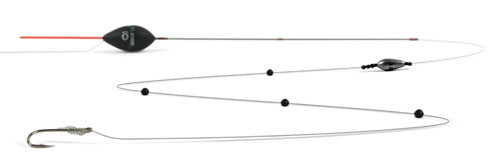
Chopped Worm
This method can be deadly at any time of the year; expect tench and eels in the warmer months and perch in the winter. A strong, durable rig is the key with a take-no-prisoners attitude that should lead to more fish in your net. This rig is usually fished down the side by any marginal features like candocks, overhanging trees or rushes. You are looking for over six feet of water to hold the fish for long periods of time. I use a Maver Series 3 pole float that has a bulbous body so I can hold it still in the flow. It has a fairly thick fibre bristle that shows up bites really well. The wire stem helps to keep the float stable in the flow. The float is mounted onto 0.18mm Silk Shock line that is fished direct to the hook in the summer, whereas in the winter I will add a 25cm hooklength of 0.12mm Silk Shock. Your hook needs to be strong and have a wide gape so it can easily hold a piece of worm. My choice is a Gamakatsu Gamma Power Barbed. Other good patterns include Tubertini Series 18, Kamasan Animal barbed or Fox Series 2 barbed. The shotting pattern is again very simple, as the fish don’t need ‘fooling’ into taking the bait. A bulk of shot or olivette depending on the size of float (shot on floats up to 0.75g, olivettes above this) sees to most of the capacity. Two No8 droppers are spaced 10cm apart below the bulk and 25cm from the hook.
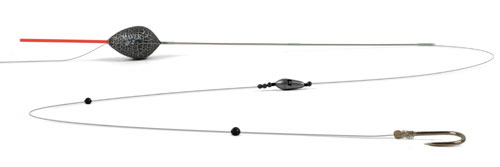
Canal
Squatt Fishing
To get the most out of squatt fishing you need to keep active and keep laying-in your rig. This will see you catching the biggest roach in your swim more often. The rig needs to be sensitive and allow the fish to take the bait before you strike. A diamond-shaped float makes the rig very versatile and can easily be lifted out and dropped back into the swim. My choice is a KC Canal with the wire stem. Other good patterns include the Fox Match MP6 or the Preston Innovations Classic 6. All these have wire stems that settle very quickly and fine fibre bristles that show up shy bites. My mainline is 0.09mm Silk Shock to a 10cm hooklength of 0.06mm Silk Shock. My hook is a very fine wire and delicate size 24 Fox Match MP1 that easily takes a single squatt and is very durable. The shotting pattern is again simple, but includes smaller shot that sink more slowly through the water – a spread bulk of No12 shot for 4×10 floats and No11 shot on 4×12 or 4×14 floats. These should be positioned about 30cm from the hooks with three No13 droppers below, spaced equally between the bulk and hooklength. Simplicity is the key along with keeping the hook bait moving, so you intercept the bigger fish off the bottom.
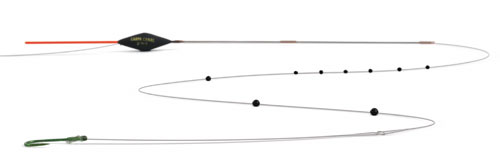
Caster
The best way to catch big fish from a canal is by fishing casters up against a far bank feature. Overhanging trees, rushes and brambles are the best looking features and depending on the canal these features can hold large roach, perch, chub and even carp! Rigs need to be durable enough to cope with ‘bonus’ fish like carp and chub but have enough finesse to fool wary fish like big roach. The ideal way is to start fishing a heavy rig and scale down to a lighter hooklength if the fishing is hard. For depths up to two feet I will use a 4×10 Preston PB8, which has a carbon stem and a fibre bristle. I would match this with 0.14mm mainline and start on a 0.12mm hooklength. Hooks should be fairly strong but small enough to hook a caster and not look too big. A size 20 is about right with Tubertini Series 18, Mustad Round Bend Match or Preston Innovations PR26 all being top match anglers’ favourites. Shotting should again be very simple and help the hook bait imitate the loose feed therefore a strung-out shirt button pattern of No11s or No10s is best. Spread the shot about 10cm apart and it should be all right.
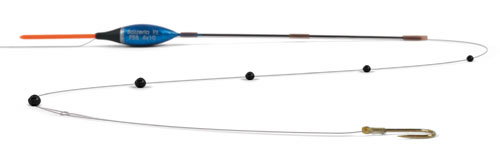
Commercial Stillwaters
Margins
At all times of the year, the margins can hold large fish, in the summer they just frequent the margins more often while in the winter they will only turn up quite late in the day once the sun has warmed the water slightly. Whatever the time of the year you need to gear yourself up accordingly. Carp are powerful fish and will break weak lines, therefore, use lines that break at over 6lb. All of my margin rigs are set to 0.18mm Silk Shock, and this is fished direct to the hook for durability. Floats need to be very strong and a thick bristle is best to reduce the amount of line bites you get when big fish rub against the line in the water and move the float around. I use KC Carpa 2s but there are lots of floats similar to this on the market like Preston Innovations PB4 or Garbolino DC6 to name just two. Shotting patterns should be very simple with a bulk of shot set at half depth. Hooks should be your favoured carp pattern.
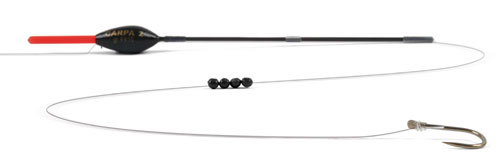
Open Water Pellet
There is no better bait to catch a weight of carp than pellets. Carp as well as many other species love them. To get the best from this bait you need to have the right rig that gives your bait a natural fall. I use a Tubertini Delta for this style of fishing as it has a fine cane bristle that is quite sensitive but doesn’t show up liners, so you shouldn’t foul-hook carp. My shotting pattern utilises styls as I think they offer a better fall over the last third of water. Seven No9 styls are used to cock the float. When fishing in open water you are less likely to find any snags that the carp can run into so you can get away with finer lines than you can when margin fishing. I start on a 0.14mm hooklength to 0.18mm mainline and if I’m catching lots I will step up to a 0.16mm hooklength. Hooks need to be strong enough to cope with carp but fine enough to sit in a small expander pellet. Hooks like Preston Innovations PR21 or Fox Match’s new Fine Wire Series Two are perfect.
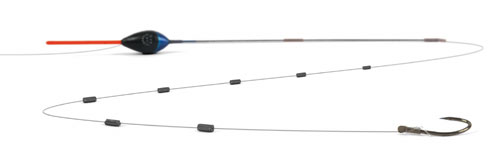
Conclusion
The main aspect of getting the right pole float is to keep it simple. From writing this feature I have realised just how many floats I actually own but don’t use. I have several patterns that do a lot of things and beyond that there are a few specialist floats for one particular method. If you keep things simple and to what you know then your catches on the pole will increase. This is also the key with shotting patterns, something I’ll be looking at in more detail next month.


